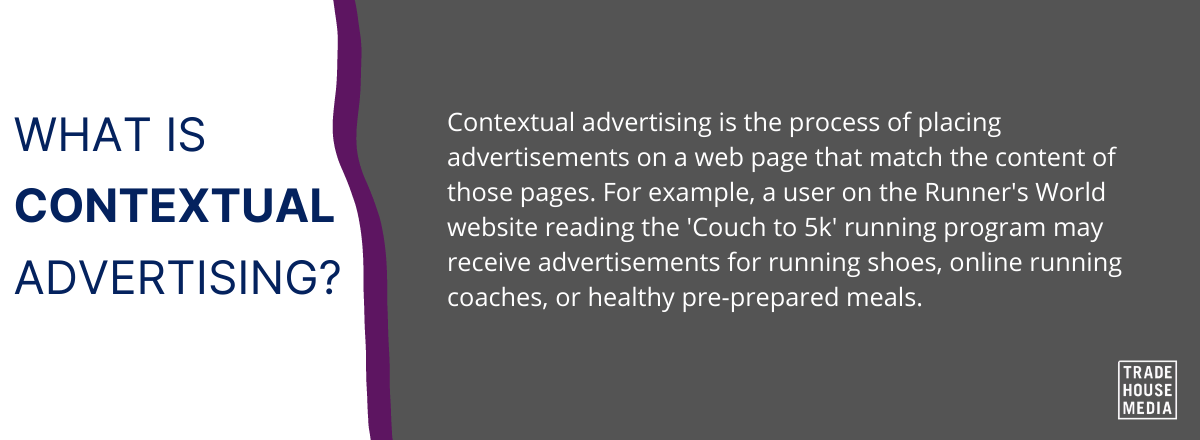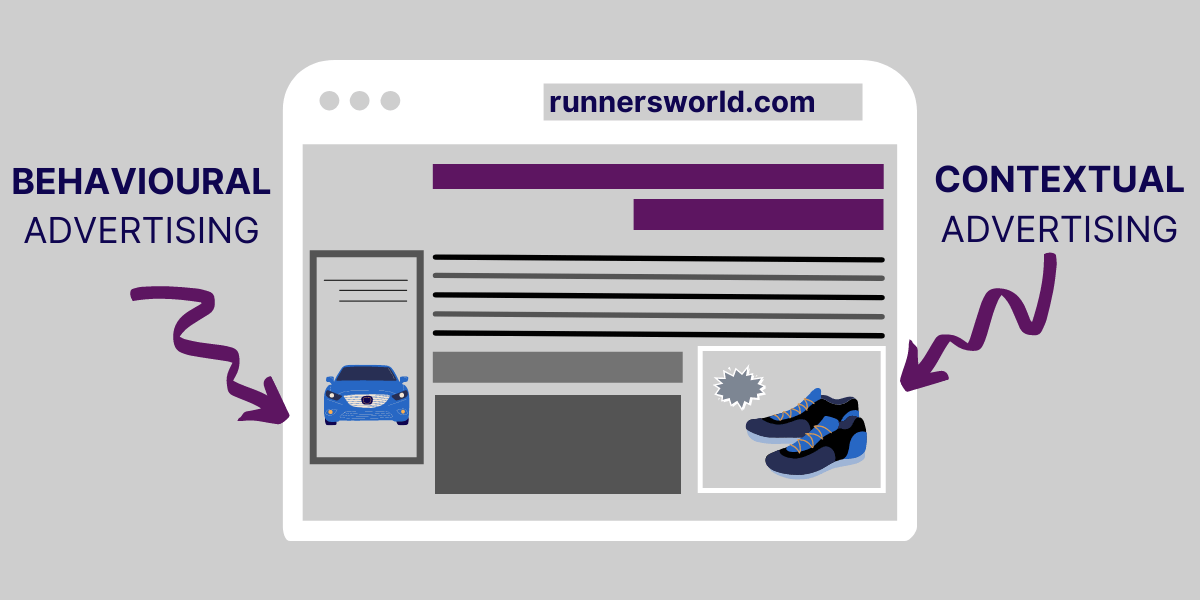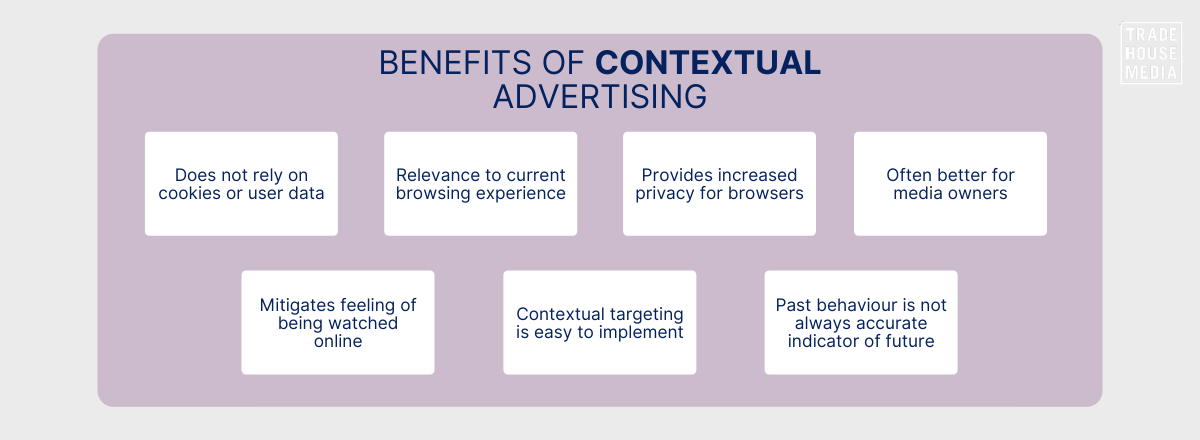Contextual advertising shapes every online browsing experience. From the ads that we are served, to the way that we move through a website, or conduct an online transaction – the underlying principles of contextual advertising are always present.
As advertising evolves and contextual ad placement radically improves ad targeting and return on ad spend, it’s important to understand how this will shape the future of online ads and what this means for users.
This article will investigate the key driving factors behind evolving online advertising models, the differences between traditional and new ads, and how this should shape decisions made by companies looking to drive their online advertising budget in 2022 and beyond.
Table of Contents
- What Is Contextual Advertising?
- How Does Contextual Targeting Work?
- What Is the Difference Between Contextual and Behavioural Advertising?
- What Are the Key Benefits of Contextual Targeting?
- How to Choose Which Advertising Strategy Is Right for You
- Embracing the Future of Contextual Ads
What Is Contextual Advertising?
Contextual advertising is the process of placing advertisements on a web page that match the content of those pages. For example, a user on the Runner’s World website reading the ‘Couch to 5k’ running program may receive advertisements for running shoes, online running coaches, or healthy pre-prepared meals.

The goal of contextual advertising is to present advertisements that are relevant to the user’s current search behaviour. Given that other online advertising models rely on ‘learned’ information to present a collection of products or services that a user may be interested in, contextual ads make use of the current online behaviour.
The data presented to users is based on the content they are browsing, rather than their previous online search history. Contextual targeting focuses on what the user is currently doing, rather than where they have come from.
Contextual advertisement is a less intrusive way of presenting information to users. Where some online advertising may make users feel that they are being ‘followed’ or ‘reminded’ of their past browsing behaviour, contextual ad targeting feels more natural and less invasive.
What Is the Difference Between Contextual and Behavioural Advertising?
The key difference between contextual and behavioural advertising is that contextual targeting relies on current browsing behaviour to serve ads. In contrast, behavioural relies on accrued browsing behaviour to serve curated advertising.
Let’s go back to the Runner’s World’ Couch to 5k’ article presented earlier. Let’s say that the user is also a car enthusiast, keen international traveller, and new father; here are some of the kinds of ads that may be served to a first-time visitor to the Runner’s World website:
Contextual ads may include:
- Running shoes
- Online running coaches
- Healthy pre-prepared meals
- Marathon entry to a local running festival
Behavioural advertising ads may include:
- Land Rover
- Car insurance
- Baby formula
- Skyscanner

As we can see, the ad experience for the contextual and behavioural advertising models is vastly different. Behavioural targeting relies on the past behaviour of a web user to gather the information that will inform the ads that are being served. Conversely, contextual targeting relies on the user’s current behaviour to display ads from a pre-defined set of keywords that match the content of a website.
How Does Contextual Advertising Work?
Contextual advertising works by matching web page content with the type of advertisement served to the user. Instead of using previous browsing history, click history, or viewership insights (this is behavioural), contextual ads are served to the user because of the web page they are on – not the web pages they have previously visited.
Contextual targeting advertisements rely on a pre-defined set of keywords or advertising parameters to serve ads through a demand-side platform. When a user navigates to a web page, the information is passed to the ad server in the form of a request. The ad server will then match the data collected about the URL and match it to relevant keywords and topic categories.
Behavioural advertising will query the user’s cookie or device ID to determine advertising options presented to the user. Conversely, contextual ads query the web page and various placement IDs to serve relevant advertising based on the user’s current activity.
What Are the Key Benefits of Contextual Advertising?
In a word – privacy.
The GDPR legislation has had a substantial impact on the digital advertising industry. The GDPR provides greater control for users and a clearer picture of how their data is being collected, handled, and distributed. The EU specific legislation led to an avalanche of emails to customers and made traditional behavioural advertising a new challenge for advertisers.
Globally, the advertising ecosystem is constantly in flux. Recently changes from big tech companies, including Apple and Google, over the last 12-months have spurred far-reaching changes to the industry. Google’s depreciation of third-party cookies (from 2023 onwards) and Apple’s IOS 14.5 privacy policy update has put advertising privacy firmly into the limelight.
The shift towards privacy-first advertising is on a fast track, and contextual ads are here to stay.
Some of the additional benefits of contextual targeting include:

- Does not rely on cookies or user data.
- Content is relevant to the current browsing experience.
- Relevant targeting can be better for media owners because they complement the content and deliver a more relevant browsing experience.
- Contextual ads are less invasive for the browser and mitigate the feeling of being followed or watched online.
- Contextual targeting is easy to implement.
- Past behaviour is not always an accurate indicator of future behaviour.
Contextual advertising does not rely on user data collected through different channels. As such, it is not subject to the same privacy regulations as behavioural ads.
Choosing between Contextual and Behavioural Ads
Why not choose both?
For publishers and advertisers, you do not need to choose between one or another. Contextual and behavioural advertising strategies both have a place in the online advertising ecosystem.
While there is a growing demand for contextual ad placement in an increasingly privacy-oriented online advertising ecosystem, behavioural advertising still offers perfect implementation, with fewer resources required to plan ads.
Speak to an Ad-Tech expert like Trade House Media to understand how you can effectively implement a multi-faceted approach to targeted online advertising.
Embracing the Future of Contextual Ads
Tightening privacy restrictions from large tech companies and regional legislation means contextual ads are here to stay. Whether you choose to use Google AdSense contextual targeting, or partner with a leading AdTech company like Trade House Media, now is the time to look at how contextual ads can fit into your online advertising strategy.
Contextual ads can effectively improve user experience, mitigate the feeling of ‘being watched online’, and empower advertisers and ad publishers to create contextual advertising experiences that complement content and effectively increase return on ad spend.

